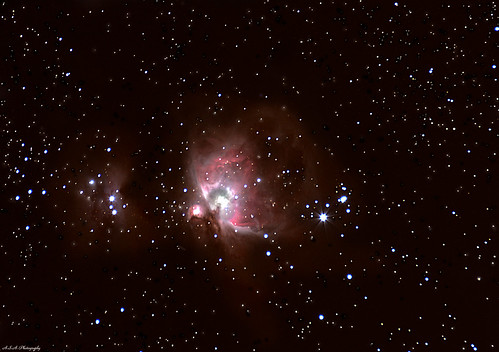Jupiter is well placed for observing on December evenings. Face east at dusk and look for the brightest thing there—that’ll be Jupiter.
Venus has fully emerged from the Sun’s glare.

 photo credit: scyllarides
photo credit: scyllarides
Look for it low in the southwest at dusk. (Venus is slightly higher in the evening sky each night this month). We are still near the beginning of Venus’ apparition as evening star; it gets higher and easier to see for the rest of this year and is spectacular for about the first half of 2012.
Mars rises around midnight and is now high in the south at dawn. Although not nearly as bright as Venus or Jupiter, Mars has brightened enough to rival the brightest stars in the sky, and will keep brightening all winter as Earth approaches it.
Saturn remains in the morning sky this month.
Look low in the southeast at dawn, near the star Spica. (From the Big Dipper’s handle, arc to Arcturus and speed on to Spica).
The Summer Triangle sets in the west. Watch for the Great Square of Pegasus almost overhead at dusk now and in the west by Christmas. Facing north, you’ll see five stars in a distinct ‘M’ like shape—this is Cassiopeia, the Queen. Her stars are about as bright as those in the Big Dipper, and she is directly across the North Star from that Dipper. In late autumn, as the Big Dipper hugs the horizon and actually sets for us in Houston, Cassiopeia is high in the north. Taurus, the Bull rises in the east. Look for the Pleiades star cluster above reddish Aldebaran. Dazzling Orion, the Hunter rises shortly after dusk (by month’s end, it is already up at dusk). As Orion enters the evening sky, we transition from the relatively dim evening skies of autumn to the brilliant stars of winter.

 photo credit: Alessandro S. Alba
photo credit: Alessandro S. Alba
| Moon Phases in December 2011: | |
| First Quarter | December 2, 3:52 am |
| Full | December 10, 8:37 am |
| Last Quarter | December 17, 6:48 pm |
| New | December 24, 12:07 pm |
The Full Moon of Saturday morning, December 10, enters the Earth’s shadow, causing a total lunar eclipse.
Unlike last year’s event, however, this eclipse heavily favors western observers in North America; we miss most of it here in Houston. However, the Moon does nick the edge of Earth’s umbra at 6:46 am that morning, when it is a scant three degrees above our horizon in Houston. If you have a northwest horizon utterly clear of trees or buildings, you might try to observe the very beginning of the eclipse before moonset.
At 11:30 pm on Wednesday, December 21, the Sun is directly overhead as seen from the Tropic of Capricorn, the farthest point south where this is possible. That makes December 21 the winter solstice, the date when the noon Sun is lowest in the sky, and when we have the fewest daylight hours of the year. However, the earliest sunset of the year here in Houston is not on the solstice, but approximately on December 2! That’s because the Earth speeds up on its orbit as it approaches perihelion (closest approach to the Sun) next month. This acceleration shifts sunrise, local noon, and sunset slightly later each day this month and next. The effect is smaller that that of the Sun taking a lower path across the sky, which normally dominates in causing earlier sunsets and later sunrises. But the Sun’s apparent path varies very little near the solstice itself, allowing the secondary effect of the Earth approaching the Sun to predominate. For most people, then, (those who witness sunset but sleep through sunrise), days will seem to lengthen throughout December, although they don’t really begin lengthening until December 21.
We are making improvements to the main telescope at George Observatory! Visitors on Saturday, December 10 and December 17 will find the 36-inch Gueymard telescope closed for repairs. Our 14-inch east dome telescope and 18-inch west dome telescope will still be open to the public, however, so we hope you’ll join us anyway! Also, Christmas Eve and New Year’s Eve fall on Saturday this year; the observatory will be closed on December 24 and 31.
Visit www.hmns.org to see the Planetarium’s film Schedule.
On most clear Saturday nights at the George Observatory, you can hear me do live star tours on the observation deck with a green laser pointer. If you’re there, listen for my announcement.



















